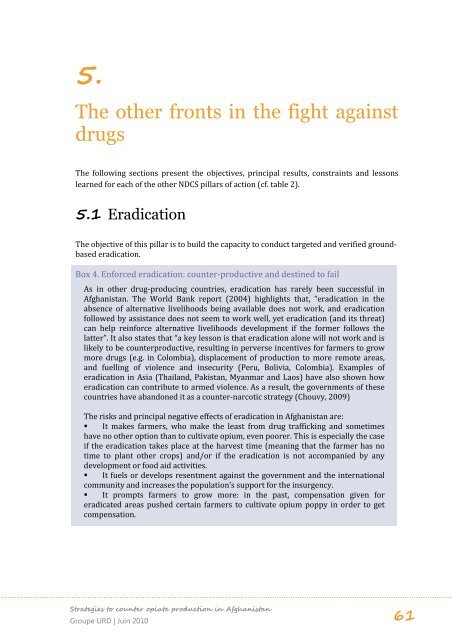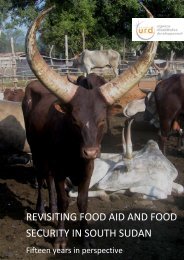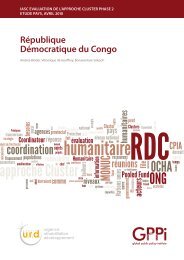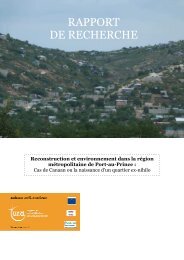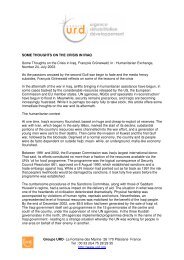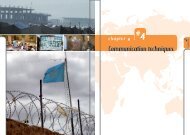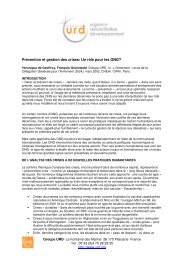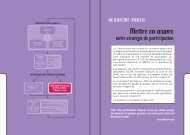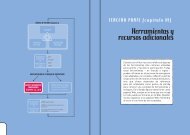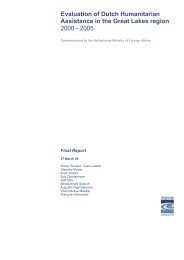strategies to counter opiate in Afghanistan - Groupe URD
strategies to counter opiate in Afghanistan - Groupe URD
strategies to counter opiate in Afghanistan - Groupe URD
You also want an ePaper? Increase the reach of your titles
YUMPU automatically turns print PDFs into web optimized ePapers that Google loves.
5.<br />
The other fronts <strong>in</strong> the fight aga<strong>in</strong>st<br />
drugs<br />
The follow<strong>in</strong>g sections present the objectives, pr<strong>in</strong>cipal results, constra<strong>in</strong>ts and lessons<br />
learned for each of the other NDCS pillars of action (cf. table 2).<br />
5.1 Eradication<br />
The objective of this pillar is <strong>to</strong> build the capacity <strong>to</strong> conduct targeted and verified groundbased<br />
eradication.<br />
Box 4. Enforced eradication: <strong>counter</strong>-productive and dest<strong>in</strong>ed <strong>to</strong> fail<br />
As <strong>in</strong> other drug-produc<strong>in</strong>g countries, eradication has rarely been successful <strong>in</strong><br />
<strong>Afghanistan</strong>. The World Bank report (2004) highlights that, “eradication <strong>in</strong> the<br />
absence of alternative livelihoods be<strong>in</strong>g available does not work, and eradication<br />
followed by assistance does not seem <strong>to</strong> work well, yet eradication (and its threat)<br />
can help re<strong>in</strong>force alternative livelihoods development if the former follows the<br />
latter”. It also states that “a key lesson is that eradication alone will not work and is<br />
likely <strong>to</strong> be <strong>counter</strong>productive, result<strong>in</strong>g <strong>in</strong> perverse <strong>in</strong>centives for farmers <strong>to</strong> grow<br />
more drugs (e.g. <strong>in</strong> Colombia), displacement of production <strong>to</strong> more remote areas,<br />
and fuell<strong>in</strong>g of violence and <strong>in</strong>security (Peru, Bolivia, Colombia). Examples of<br />
eradication <strong>in</strong> Asia (Thailand, Pakistan, Myanmar and Laos) have also shown how<br />
eradication can contribute <strong>to</strong> armed violence. As a result, the governments of these<br />
countries have abandoned it as a <strong>counter</strong>-narcotic strategy (Chouvy, 2009)<br />
The risks and pr<strong>in</strong>cipal negative effects of eradication <strong>in</strong> <strong>Afghanistan</strong> are:<br />
It makes farmers, who make the least from drug traffick<strong>in</strong>g and sometimes<br />
have no other option than <strong>to</strong> cultivate opium, even poorer. This is especially the case<br />
if the eradication takes place at the harvest time (mean<strong>in</strong>g that the farmer has no<br />
time <strong>to</strong> plant other crops) and/or if the eradication is not accompanied by any<br />
development or food aid activities.<br />
It fuels or develops resentment aga<strong>in</strong>st the government and the <strong>in</strong>ternational<br />
community and <strong>in</strong>creases the population’s support for the <strong>in</strong>surgency.<br />
It prompts farmers <strong>to</strong> grow more: <strong>in</strong> the past, compensation given for<br />
eradicated areas pushed certa<strong>in</strong> farmers <strong>to</strong> cultivate opium poppy <strong>in</strong> order <strong>to</strong> get<br />
compensation.<br />
Strategies <strong>to</strong> <strong>counter</strong> <strong>opiate</strong> production <strong>in</strong> <strong>Afghanistan</strong><br />
<strong>Groupe</strong> <strong>URD</strong> | Ju<strong>in</strong> 2010<br />
61


